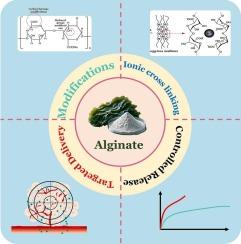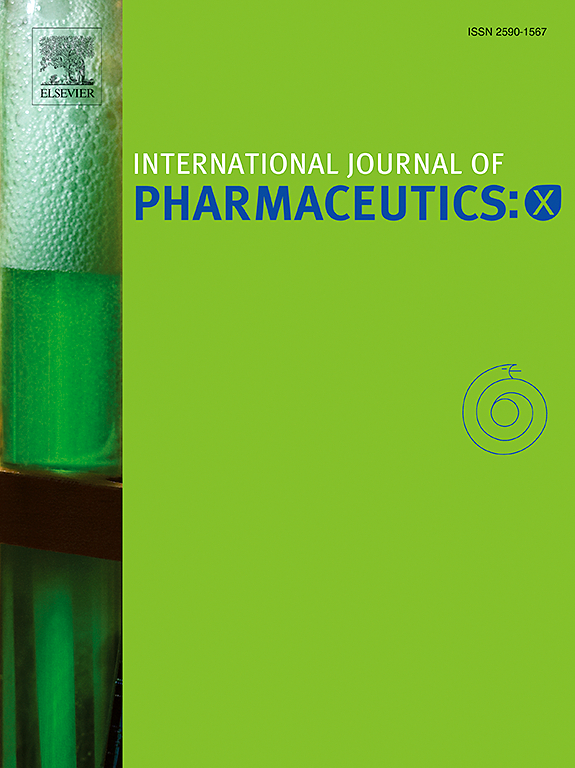Modified alginates for precision drug delivery: Advances in controlled-release and targeting systems
IF 6.4
2区 医学
Q1 PHARMACOLOGY & PHARMACY
引用次数: 0
Abstract
Alginates have been modified to become a suitable platform for targeted drug release, triggering advances in targeted and controlled-release systems. Alginate chemistry and various structural modifications, including ionic crosslinking, cyclodextrin-linking, and chemical carboxyl and hydroxyl group modification, such as esterification, amidation, and sulfation, are covered in this review. These modifications are aimed at enhancing drug release mechanisms, like dissolution, diffusion, water penetration, and ion exchange-based systems. Application of modified alginates in controlled-release systems is extensive, from hydrogels, bioprinting approaches, nanofiber-based systems, in-situ gelling systems, to nanoparticle systems. Targeted drug delivery utilizes passive and active targeting strategies for numerous applications, including the treatment of cancer, inflammatory disease therapy, infectious disease, and wound healing. Emerging platforms such as hydrogels and nanoparticles provide evidence of the versatility of modified alginates. However, issues regarding scalability and biocompatibility remain as obstacles. In this review, the capabilities of alginate-based delivery systems and their role in making various release mechanisms for targeted delivery are discussed in relation to the future directions for precision medicine development.

用于精确给药的修饰海藻酸盐:控释和靶向系统的研究进展
海藻酸盐已被改造成为靶向药物释放的合适平台,引发靶向和控释系统的进展。海藻酸盐的化学和各种结构修饰,包括离子交联、环糊精连接和化学羧基和羟基修饰,如酯化、酰胺化和磺化,在此综述。这些修饰旨在增强药物释放机制,如溶解、扩散、水渗透和基于离子交换的系统。改性海藻酸盐在控释系统中的应用非常广泛,从水凝胶、生物打印方法、纳米纤维系统、原位胶凝系统到纳米颗粒系统。靶向药物递送利用被动和主动靶向策略进行许多应用,包括治疗癌症,炎症性疾病治疗,感染性疾病和伤口愈合。新兴的平台,如水凝胶和纳米颗粒,证明了改性海藻酸盐的多功能性。然而,关于可扩展性和生物相容性的问题仍然是障碍。本文就海藻酸盐为基础的给药系统的功能及其在多种靶向释放机制中的作用进行了综述,并对未来精准医学的发展方向进行了展望。
本文章由计算机程序翻译,如有差异,请以英文原文为准。
求助全文
约1分钟内获得全文
求助全文
来源期刊

International Journal of Pharmaceutics: X
Pharmacology, Toxicology and Pharmaceutics-Pharmaceutical Science
CiteScore
6.60
自引率
0.00%
发文量
32
审稿时长
24 days
期刊介绍:
International Journal of Pharmaceutics: X offers authors with high-quality research who want to publish in a gold open access journal the opportunity to make their work immediately, permanently, and freely accessible.
International Journal of Pharmaceutics: X authors will pay an article publishing charge (APC), have a choice of license options, and retain copyright. Please check the APC here. The journal is indexed in SCOPUS, PUBMED, PMC and DOAJ.
The International Journal of Pharmaceutics is the second most cited journal in the "Pharmacy & Pharmacology" category out of 358 journals, being the true home for pharmaceutical scientists concerned with the physical, chemical and biological properties of devices and delivery systems for drugs, vaccines and biologicals, including their design, manufacture and evaluation. This includes evaluation of the properties of drugs, excipients such as surfactants and polymers and novel materials. The journal has special sections on pharmaceutical nanotechnology and personalized medicines, and publishes research papers, reviews, commentaries and letters to the editor as well as special issues.
 求助内容:
求助内容: 应助结果提醒方式:
应助结果提醒方式:


